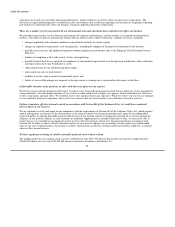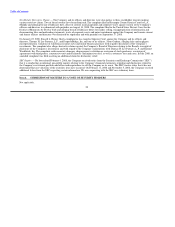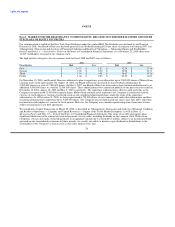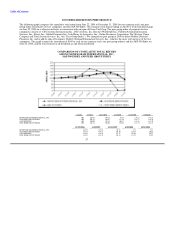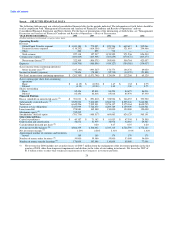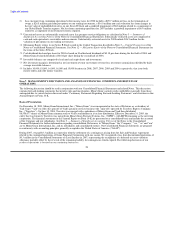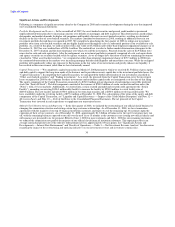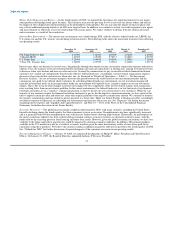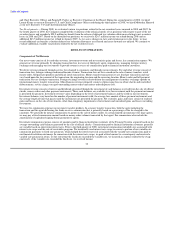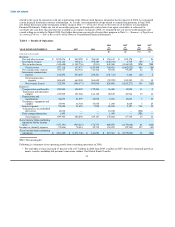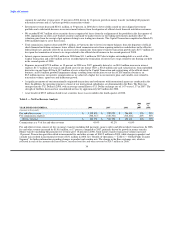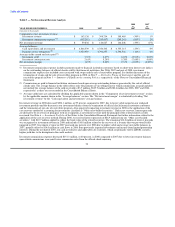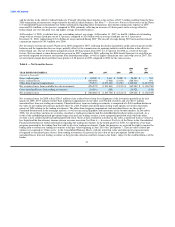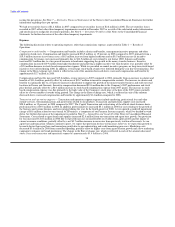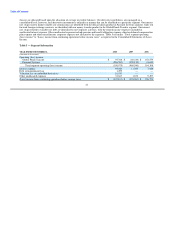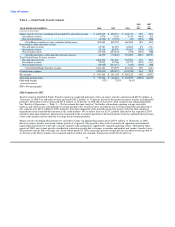MoneyGram 2008 Annual Report Download - page 35
Download and view the complete annual report
Please find page 35 of the 2008 MoneyGram annual report below. You can navigate through the pages in the report by either clicking on the pages listed below, or by using the keyword search tool below to find specific information within the annual report.
Table of Contents
and Chief Executive Officer and Pamela H. Patsley as Executive Chairman of the Board. During the second quarter of 2008, we hired
Lonnie Keene as our new Executive V.P. and Chief Compliance Officer and during the third quarter of 2008, we hired Mubashar Hameed
as our new Executive V.P and Chief Information Officer.
Tax Developments — During 2008, we evaluated various tax positions related to the net securities losses incurred in 2008 and 2007. In
the fourth quarter of 2008, the Company completed the evaluation of the technical merits of tax positions with respect to part of the net
securities losses and recorded a $90.5 million tax benefit from the release of deferred tax valuation allowances relating to net securities
losses in 2008 and 2007. Based on the identified tax positions, we received a $24.7 million income tax refund during 2008 and an
additional $43.5 million income tax refund in January 2009. As we assess changes in facts and circumstances in the future, we may
record additional tax benefits as further deferred tax valuation allowances are released and carry-forwards are utilized. We continue to
evaluate additional available tax positions related to the net securities losses.
RESULTS OF OPERATIONS
Components of Net Revenue
Our net revenue consists of fee and other revenue, investment revenue and net securities gains and losses, less commission expense. We
generate net revenue primarily by charging transaction fees in excess of third-party agent commissions, managing foreign currency
exchange and managing our investments to provide returns in excess of commissions paid to financial institution customers.
We derive revenue primarily through service fees charged to consumers and through our investments. Fee and other revenue consist of
transaction fees, foreign exchange and miscellaneous revenue. Transaction fees are fees earned on the sale of money transfers, retail
money order, bill payment products and official check transactions. Money transfer transaction fees are fixed per transaction and may
vary based upon the face amount of the transaction, the originating location and the receiving location. Money order and bill payment
transaction fees are fixed per transaction. Foreign exchange revenue is derived from the management of currency exchange spreads on
international money transfer transactions. Miscellaneous revenue primarily consists of processing fees on rebate checks and controlled
disbursements, service charges on aged outstanding money orders and money order dispenser fees.
Investment revenue consists of interest and dividends generated through the investment of cash balances received from the sale of official
checks, money orders and other payment instruments. These cash balances are available to us for investment until the payment instrument
is presented for payment. Investment revenue varies depending on the level of investment balances and the yield on our investments.
Investment balances vary based on the number of payment instruments sold, the average face amount of those payment instruments and
the average length of time that passes until the instruments are presented for payment. Net securities gains and losses consist of realized
gains and losses on the sale of investments, other-than-temporary impairments of investments and unrealized gains and losses on trading
investments.
We incur fee commission expense on our money transfer products. In a money transfer transaction, both the agent initiating the
transaction and the agent disbursing the funds receive a commission that is generally based on a percentage of the fee charged to the
consumer. We generally do not pay commissions to agents on the sale of money orders. In certain limited circumstances for large agents,
we may pay a fixed commission amount based on money order volumes transacted by that agent. Fee commissions also include the
amortization of capitalized signing bonus payments to agents.
Investment commission expense consists of amounts paid to financial institution customers of the Payment Systems segment based on the
average outstanding cash balances generated by the sale of official checks. Commissions paid to financial institution customers generally
are variable based on short-term interest rates. Prior to the third quarter of 2008, investment commissions included costs associated with
interest rate swaps and the sale of receivables program. We historically used interest rate swaps to convert a portion of our variable rate
commission payments to fixed rate payments, which hedged the interest rate risk associated with the variable rate commissions paid to
our financial institution customers. In connection with the interest rate swaps, we paid a fixed amount to a counterparty and received a
variable rate payment in return. To the extent that the fixed rate exceeded the variable rate, we incurred an expense related to the swap;
conversely, if the variable rate exceeded the fixed rate, we received income
32


